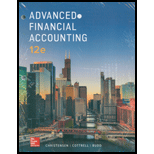
ADVANCED FINANCIAL ACCT.(LL) >CUSTOM<
12th Edition
ISBN: 9781260824292
Author: Christensen
Publisher: MCGRAW-HILL HIGHER EDUCATION
expand_more
expand_more
format_list_bulleted
Textbook Question
Chapter 8, Problem 8.12Q
How is the amount of income assigned to the noncontrolling interest affected by the direct placement of a subsidiary’s bonds with the parent company?
Expert Solution & Answer
Want to see the full answer?
Check out a sample textbook solution
Students have asked these similar questions
Please explain the correct approach for solving this general accounting question.
Valmont Electronics Inc. purchases and resells laptops. On October 10th, 2023, the company purchased 4,500 laptops for $350 each. On October 30th, the company sells 1,200 units for $520 each. What is the cost of goods sold on the sale?
Last year Kellner Corporation reported cost of goods sold of $180,000. Inventories decreased by $15,000 during the year, and accounts payable increased by $8,000. The company uses the direct method to determine the net cash flows from operating activities on the statement of cash flows. The cost of goods sold adjusted to a cash basis would be: a. $203,000 b. $157,000 c. $165,000 d. $172,000
Chapter 8 Solutions
ADVANCED FINANCIAL ACCT.(LL) >CUSTOM<
Ch. 8 - Prob. 8.1QCh. 8 - What is meant by a constructive bond retirement in...Ch. 8 - Prob. 8.3QCh. 8 - Prob. 8.4QCh. 8 - When a parent company sells land to a subsidiary...Ch. 8 - Prob. 8.7QCh. 8 - Prob. 8.8QCh. 8 - Prob. 8.9QCh. 8 - Prob. 8.10QCh. 8 - Prob. 8.11Q
Ch. 8 - How is the amount of income assigned to the...Ch. 8 - Prob. 8.13QCh. 8 - How would the relationship between interest income...Ch. 8 - Prob. 8.15QCh. 8 - Prob. 8.16QCh. 8 - Prob. 8.17QCh. 8 - Prob. 8.18QCh. 8 - Prob. 8.1CCh. 8 - Prob. 8.2CCh. 8 - Prob. 8.4CCh. 8 - Prob. 8.1ECh. 8 - Bond Sale from Parent to Subsidiary (StraightLine...Ch. 8 - Computation of Transfer Price (Effective Interest...Ch. 8 - Prob. 8.2AECh. 8 - Prob. 8.3ECh. 8 - Bond Sale at Discount (Straightline Method) Assume...Ch. 8 - Evaluation of Intercorporate Bond Holdings...Ch. 8 - Prob. 8.5.1ECh. 8 - Prob. 8.5.2ECh. 8 - MultipleChoice Questions (Effective Interest...Ch. 8 - Prob. 8.5.4ECh. 8 - Prob. 8.5.5ECh. 8 - Prob. 8.5.6ECh. 8 - Prob. 8.5.1AECh. 8 - Prob. 8.5.2AECh. 8 - Prob. 8.5.3AECh. 8 - Prob. 8.5.4AECh. 8 - Prob. 8.6.1ECh. 8 - Prob. 8.6.2ECh. 8 - MultipleChoice Questions (Effective Interest...Ch. 8 - Prob. 8.6.1AECh. 8 - Prob. 8.6.2AECh. 8 - Prob. 8.6.3AECh. 8 - Prob. 8.7ECh. 8 - Prob. 8.7AECh. 8 - Prob. 8.8ECh. 8 - Prob. 8.8AECh. 8 - Prob. 8.9ECh. 8 - Prob. 8.9AECh. 8 - Prob. 8.10ECh. 8 - Prob. 8.10AECh. 8 - Prob. 8.11ECh. 8 - Prob. 8.11AECh. 8 - Evaluation of Bond Retirement (Effective Interest...Ch. 8 - Prob. 8.12AECh. 8 - Prob. 8.13ECh. 8 - Prob. 8.13AECh. 8 - Prob. 8.14PCh. 8 - Prob. 8.14APCh. 8 - Prob. 8.15PCh. 8 - Prob. 8.15APCh. 8 - Prob. 8.16PCh. 8 - Prob. 8.16APCh. 8 - Prob. 8.17PCh. 8 - Prob. 8.17APCh. 8 - Prob. 8.18PCh. 8 - Prob. 8.18APCh. 8 - Prob. 8.19APCh. 8 - Prob. 8.20PCh. 8 - Prob. 8.20APCh. 8 - Prob. 8.21PCh. 8 - Prob. 8.21APCh. 8 - Prob. 8.22APCh. 8 - Prob. 8.22BPCh. 8 - Prob. 8.23PCh. 8 - Prob. 8.23APCh. 8 - Prob. 8.24PCh. 8 - Prob. 8.24APCh. 8 - Intercorporate Inventory and Debt Transfers...Ch. 8 - Intercorporate Inventory and Debt Transfers...Ch. 8 - Prob. 8.26PCh. 8 - Prob. 8.26APCh. 8 - Prob. 8.27.1BPCh. 8 - Prob. 8.27.2BPCh. 8 - Prob. 8.27.3BPCh. 8 - Prob. 8.27.4BPCh. 8 - Prob. 8.27.5BPCh. 8 - Prob. 8.27.6BPCh. 8 - Prob. 8.27.7BPCh. 8 - Prob. 8.27.8BPCh. 8 - Prob. 8.27.9BPCh. 8 - Prob. 8.27.10BPCh. 8 - Prob. 8.28PCh. 8 - Prob. 8.28APCh. 8 - Prob. 8.29BPCh. 8 - Prob. 8.30BP
Knowledge Booster
Learn more about
Need a deep-dive on the concept behind this application? Look no further. Learn more about this topic, accounting and related others by exploring similar questions and additional content below.Similar questions
- I need help with this financial accounting problem using proper accounting guidelines.arrow_forwardI am looking for help with this general accounting question using proper accounting standards.arrow_forwardI am trying to find the accurate solution to this general accounting problem with the correct explanation.arrow_forward
- Please provide the answer to this general accounting question with proper steps.arrow_forwardPlease explain the solution to this general accounting problem using the correct accounting principles.arrow_forwardPlease provide the accurate answer to this general accounting problem using valid techniques.arrow_forward
arrow_back_ios
SEE MORE QUESTIONS
arrow_forward_ios
Recommended textbooks for you
 Intermediate Accounting: Reporting And AnalysisAccountingISBN:9781337788281Author:James M. Wahlen, Jefferson P. Jones, Donald PagachPublisher:Cengage LearningPrinciples of Accounting Volume 1AccountingISBN:9781947172685Author:OpenStaxPublisher:OpenStax College
Intermediate Accounting: Reporting And AnalysisAccountingISBN:9781337788281Author:James M. Wahlen, Jefferson P. Jones, Donald PagachPublisher:Cengage LearningPrinciples of Accounting Volume 1AccountingISBN:9781947172685Author:OpenStaxPublisher:OpenStax College

Intermediate Accounting: Reporting And Analysis
Accounting
ISBN:9781337788281
Author:James M. Wahlen, Jefferson P. Jones, Donald Pagach
Publisher:Cengage Learning

Principles of Accounting Volume 1
Accounting
ISBN:9781947172685
Author:OpenStax
Publisher:OpenStax College



GOVERNANCE OF GLOBAL ISSUES THROUGH INTERNATIONAL TRADE AGREEMENTS| IE EXPLAINS; Author: IE University;https://www.youtube.com/watch?v=1hBf1VzO3K8;License: Standard Youtube License